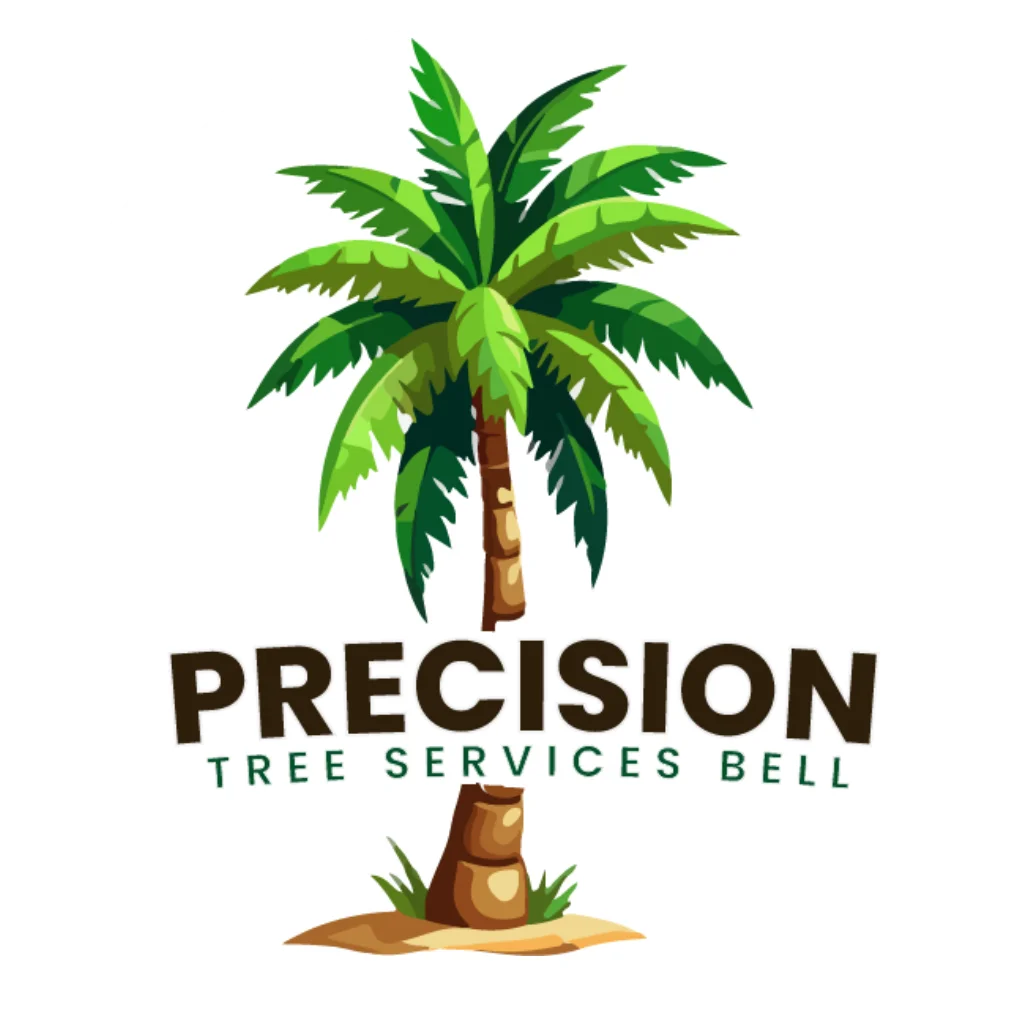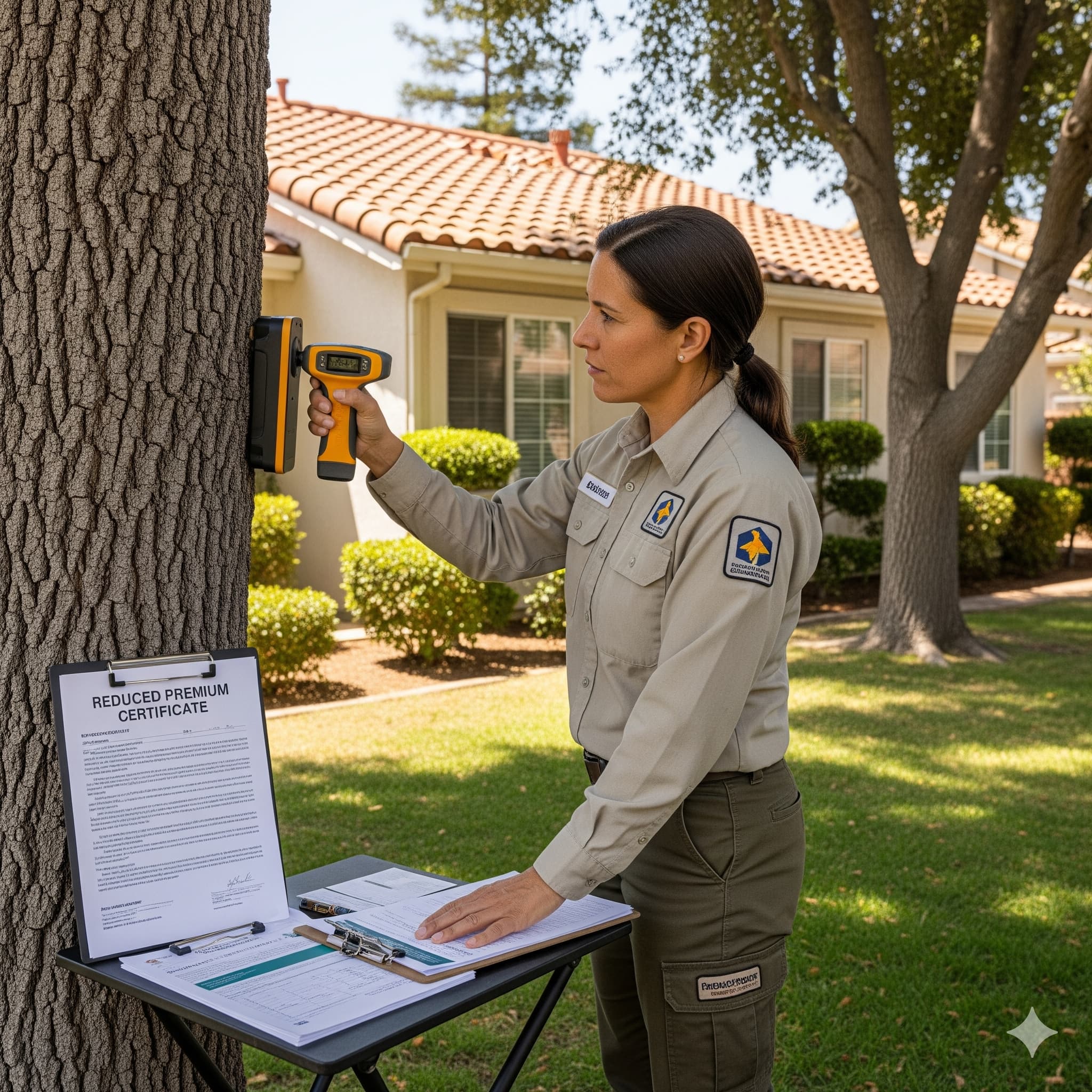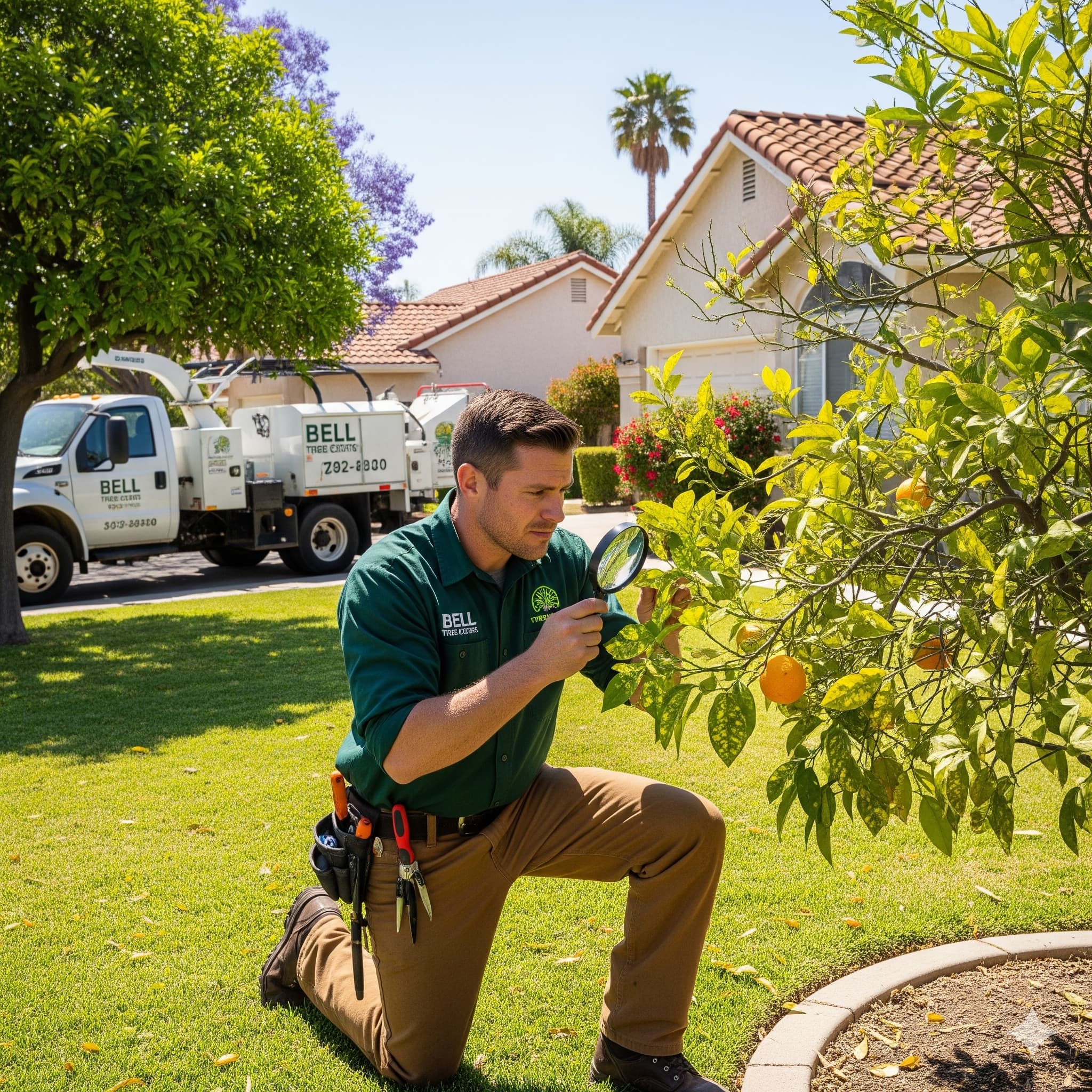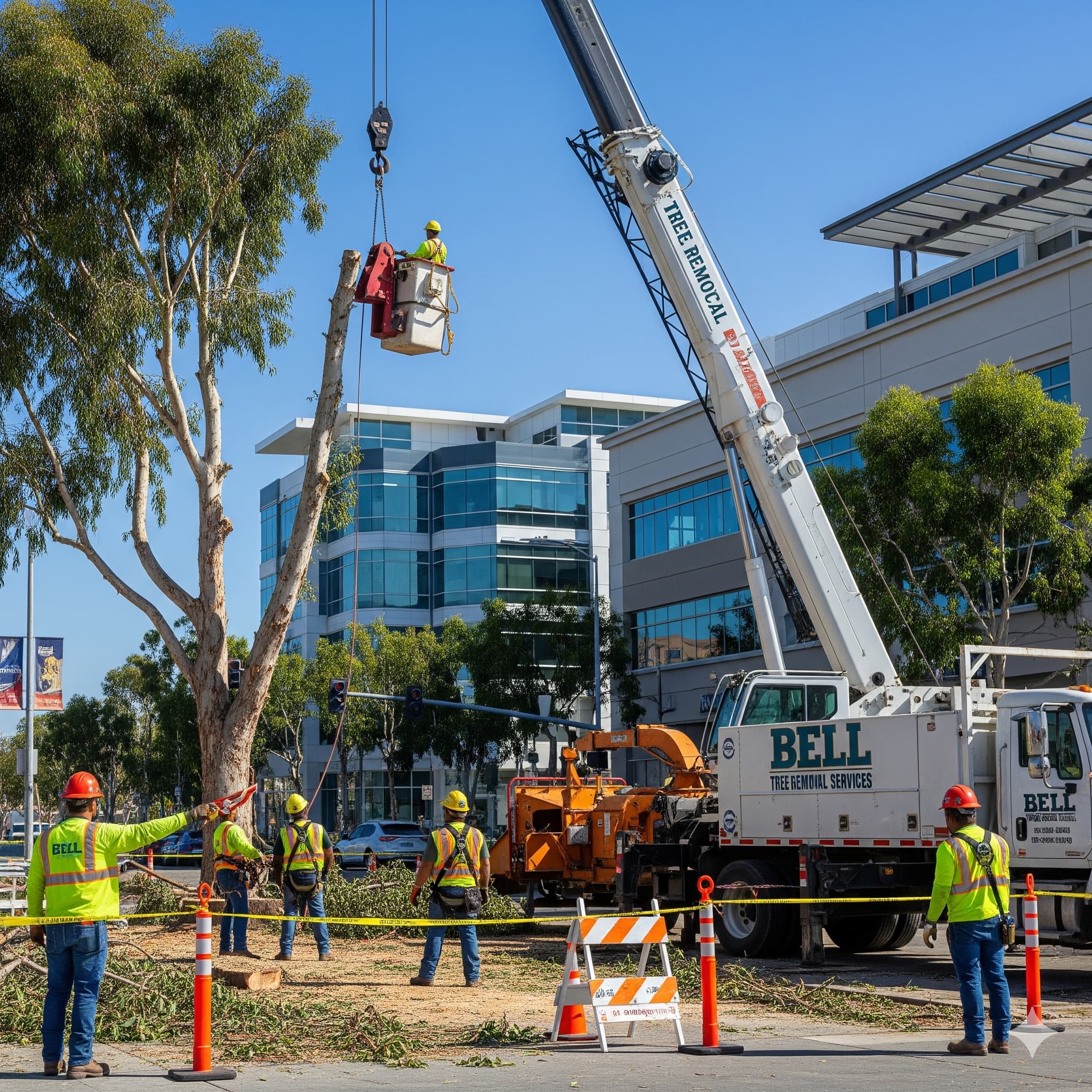
Bell Commercial Tree Service: OSHA & City Safety Compliance
Commercial properties in Bell, California require specialized tree removal services that meet stringent OSHA safety standards and local city compliance requirements. Professional commercial tree removal involves complex safety protocols, regulatory compliance, and specialized equipment that distinguishes it from residential tree work. Understanding these requirements ensures businesses maintain safe work environments while avoiding costly violations and liability issues.
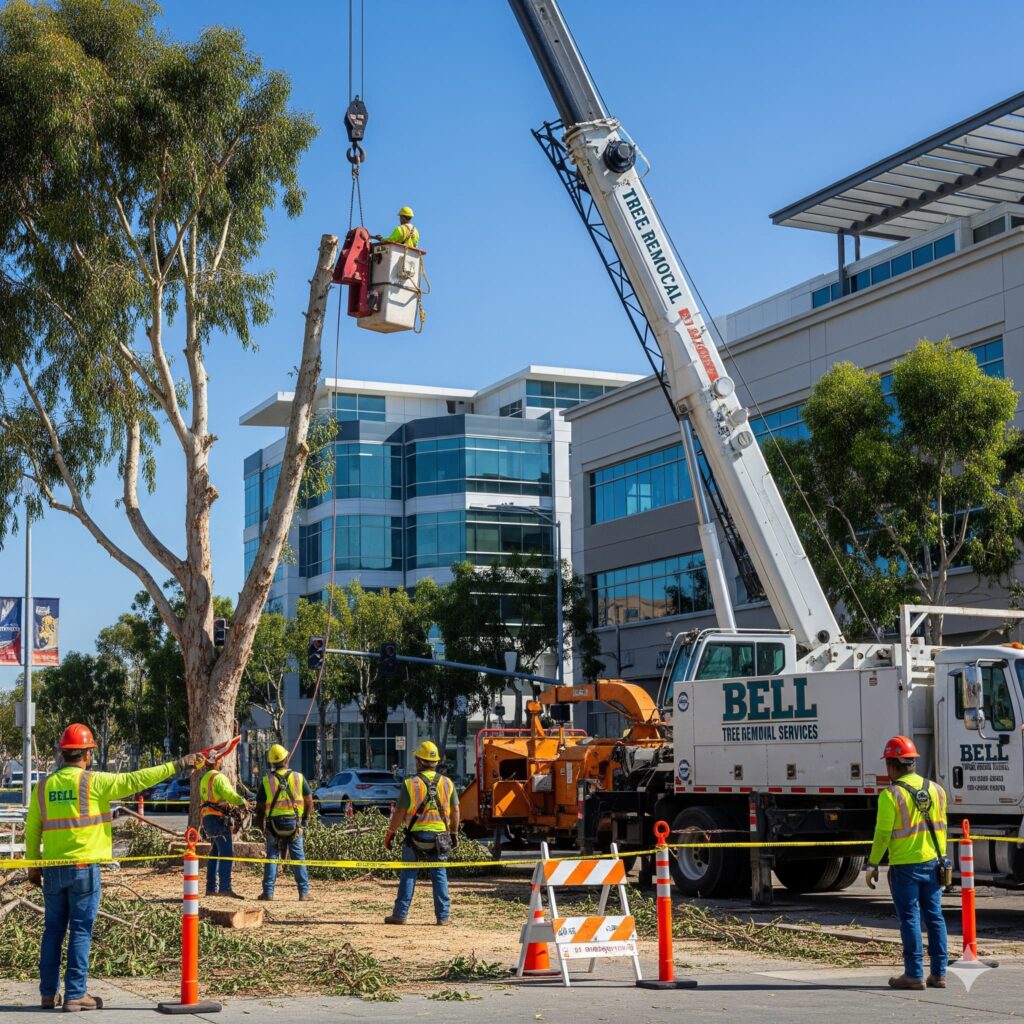
OSHA Safety Standards for Commercial Tree Operations
Tree Care Industry Safety Regulations
OSHA recognizes tree care as one of America’s most dangerous professions, with a fatality rate of 110 per 100,000 workers. Commercial tree removal operations must comply with specific OSHA standards, including the Logging Operations Standard (29 CFR 1910.266) and general industry safety requirements. These regulations address the unique hazards associated with tree work, including falls, struck-by incidents, and equipment-related injuries.
The proposed Tree Care Operations rulemaking focuses specifically on protecting workers who prune, repair, maintain, or remove trees, as well as those providing on-site support services. Commercial operations face heightened scrutiny due to the scale of work and potential impact on surrounding businesses and public areas.
OSHA standards require comprehensive safety programs including regular training, proper personal protective equipment (PPE), hazard identification procedures, and emergency response protocols. Commercial tree removal companies must document compliance efforts and maintain detailed safety records for inspection purposes.
Fall Protection and Personal Protective Equipment
Commercial tree removal requires specialized fall protection systems that exceed basic safety requirements. Workers must use approved climbing harnesses, lanyards, and positioning devices specifically designed for tree work. Equipment must meet ANSI standards and be regularly inspected for wear or damage.
PPE requirements include cut-resistant pants, chainsaw chaps, protective helmets with face shields, hearing protection, and high-visibility clothing. Commercial operations often work in high-traffic areas where visibility becomes critical for worker safety and public protection.
Fall protection systems must be designed for the specific hazards of each job site, considering factors like tree height, surrounding structures, and ground conditions. Professional commercial tree removal services maintain comprehensive fall protection programs with regular training and equipment updates.
Equipment Safety and Maintenance Standards
Commercial tree removal involves heavy machinery, including bucket trucks, cranes, stump grinders, and wood chippers that must meet specific OSHA safety requirements. Equipment manufactured after certain dates must include Rollover Protective Structure (ROPS) and Falling Object Protective Structure (FOPS) to protect operators.
All equipment requires regular maintenance, inspection, and documentation to ensure safe operation. Commercial operations must maintain detailed maintenance records and ensure that only qualified operators use specialized equipment. Safety features like backup alarms, warning lights, and emergency stops must be functional at all times.
Vehicle and equipment positioning becomes critical in commercial settings where work occurs near buildings, parking areas, and public walkways. Professional services develop site-specific safety plans that address equipment placement, traffic control, and pedestrian protection.
Bell City Compliance Requirements
Commercial Property Regulations
Bell’s municipal code requires specific permits and approvals for commercial tree removal projects, particularly those involving large trees or trees in public right-of-way areas. Commercial properties must comply with city tree preservation ordinances while meeting business operational needs.
Site Plan Reviews (SPR) may be required for commercial tree removal projects, depending on the scope and location of work. Any construction or development project, including tree removal that supports commercial development, requires approval through the city’s planning process.
Commercial property owners must coordinate with Bell’s Building and Safety Division for projects that might affect structures, utilities, or public access. The city requires advance notification for work that could impact traffic flow or require temporary road closures.
Permit Requirements and Processing
Commercial tree removal permits in Bell follow the city’s standard permitting process, which requires detailed project plans and professional documentation. Applications must include site plans showing all structures, existing trees, and proposed removal areas.
The permit review process typically takes 10-15 business days for standard commercial projects, with larger or more complex projects requiring additional time. Multi-story commercial buildings or projects affecting multiple properties may require extended review periods and additional approvals.
Professional documentation from certified arborists may be required to justify tree removal, particularly for large or significant trees. Environmental impact assessments might be necessary for extensive commercial development projects involving multiple tree removals.
Public Safety and Traffic Management
Commercial tree removal in Bell often requires coordination with city departments for traffic management and public safety. Work zones must be clearly marked to prevent accidental entry by pedestrians or vehicles, with proper signage and barriers installed according to city standards.
Projects affecting public right-of-way require coordination with the Department of Transportation and may require flaggers or traffic control devices. Commercial operations must maintain safe pedestrian access around business districts while conducting tree removal operations.
Emergency response protocols must be established for commercial projects, including procedures for evacuating nearby businesses if dangerous conditions develop. Professional services coordinate with local emergency services and maintain communication with building management throughout projects.
Precision Tree Services Bell: Professional Commercial Solutions
Certified Commercial Tree Removal Specialists
Precision Tree Services Bell provides comprehensive commercial tree removal services designed to meet OSHA standards and Bell city requirements. Our certified arborists understand the unique challenges of commercial tree work and maintain all necessary licensing and insurance for business property services.
We specialize in complex commercial projects, including office buildings, retail centers, industrial facilities, and mixed-use developments throughout Bell. Our experience with commercial properties near landmarks like Bell High School and the Bell Community Center demonstrates our ability to work safely in high-visibility public areas.
Our commercial services include pre-project planning, permit acquisition assistance, safety plan development, and coordination with city departments. This comprehensive approach ensures projects proceed smoothly while maintaining compliance with all applicable regulations.
OSHA-Compliant Safety Programs
We maintain comprehensive safety programs that exceed OSHA requirements for tree care operations. Our safety protocols include regular training updates, documented safety meetings, and continuous equipment maintenance programs that ensure worker and public safety.
All crew members receive OSHA-approved training in fall protection, equipment operation, hazard recognition, and emergency response procedures. We conduct regular safety audits and maintain detailed documentation of compliance efforts for client review and regulatory inspection.
Our safety programs address the specific challenges of commercial tree removal, including working around occupied buildings, managing public access, and coordinating with other contractors. This systematic approach minimizes liability exposure for commercial property owners while ensuring project completion.
Specialized Commercial Equipment and Techniques
Commercial tree removal often requires specialized equipment not typically used for residential work. We maintain a fleet of commercial-grade equipment, including large capacity cranes, aerial lifts, and industrial wood processing equipment designed for efficiency and safety.
Our equipment meets or exceeds OSHA safety requirements, including ROPS and FOPS protection, advanced hydraulic systems, and comprehensive safety monitoring. Regular maintenance and inspection programs ensure optimal performance and regulatory compliance.
We utilize advanced rigging techniques and controlled demolition methods that enable safe tree removal in constrained commercial environments. These specialized approaches minimize disruption to business operations while maintaining the highest safety standards.
Commercial Project Risk Management
Liability and Insurance Considerations
Commercial tree removal involves significant liability exposure requiring comprehensive insurance coverage and risk management strategies. Professional services maintain commercial general liability, workers’ compensation, and professional liability insurance specifically designed for tree care operations.
Risk management extends beyond insurance to include detailed project planning, safety assessments, and coordination with property owners and tenants. Professional services conduct pre-project meetings to identify potential hazards and develop mitigation strategies.
Documentation becomes critical for commercial projects, with detailed records of safety procedures, permit compliance, and project execution. This documentation protects both service providers and property owners in the event of incidents or regulatory inquiries.
Business Continuity Planning
Commercial tree removal projects must consider the operational needs of affected businesses while maintaining safety requirements. Professional services develop project schedules that minimize disruption to business operations while ensuring adequate time for safe work completion.
Coordination with building management and tenant businesses helps identify critical operational periods that should be avoided during tree removal operations. This planning approach maintains positive relationships while ensuring project success.
Emergency response protocols include procedures for quickly securing work sites if unexpected conditions develop, ensuring that business operations can resume safely. Communication plans keep all stakeholders informed throughout project execution.
Environmental and Community Impact
Commercial tree removal projects often receive public attention, requiring careful management of environmental and community concerns. Professional services provide documentation of tree condition assessments and replacement planning to address community concerns about urban forest preservation.
Environmental considerations include dust control, noise management, and protection of surrounding vegetation during commercial tree removal operations. These factors become particularly important for projects near schools, hospitals, or residential areas.
Community relations include advance notification of surrounding businesses and residents about project schedules and potential impacts. Professional communication helps maintain positive relationships while ensuring the public understands the necessary tree removal work.
Regulatory Compliance and Documentation
OSHA Inspection Preparedness
Commercial tree removal operations must maintain inspection-ready documentation demonstrating compliance with OSHA safety standards. This includes training records, equipment inspection logs, incident reports, and safety program documentation.
Professional services conduct regular internal audits to ensure compliance documentation remains current and complete. These proactive measures help identify potential compliance issues before they become regulatory problems.
Inspection preparedness includes maintaining clear communication channels with regulatory agencies and understanding current enforcement priorities. This knowledge helps ensure that safety programs address the most critical compliance areas.
Cal/OSHA Specific Requirements
California’s Division of Occupational Safety and Health (Cal/OSHA) enforces additional requirements beyond federal OSHA standards. These state-specific regulations address unique California workplace safety concerns, including heat illness prevention and earthquake safety considerations.
Cal/OSHA requirements include specific training elements, documentation standards, and reporting procedures that commercial tree removal operations must follow. Professional services maintain current knowledge of state regulatory changes and update programs accordingly.
Compliance with Cal/OSHA requirements often exceeds federal standards, requiring enhanced safety programs and more detailed documentation. This elevated compliance level provides additional protection for workers and commercial property owners.
Municipal Code Compliance
Bell’s municipal code includes specific requirements for commercial tree removal that complement state and federal safety regulations. These local requirements address community concerns about tree preservation, public safety, and environmental protection.
Commercial operations must coordinate with multiple city departments, including Planning, Building and Safety, and Public Works, to ensure comprehensive compliance. This coordination requires an understanding of local procedures and maintaining relationships with city officials.
Municipal compliance documentation becomes part of the permanent project record and may be reviewed during future development or permitting activities. Professional services ensure that all local requirements are met and properly documented.
Advanced Commercial Tree Removal Techniques
Crane-Assisted Removal Operations
Large commercial tree removal projects often require crane assistance to safely remove trees in constrained environments. Crane operations involve additional safety requirements, including certified crane operators, rigging specialists, and detailed lift plans.
Crane-assisted removal enables efficient removal of large trees without damage to surrounding structures or landscaping. This technique proves particularly valuable for commercial properties where access is limited or where traditional removal methods would create unacceptable risks.
Safety protocols for crane operations include establishing exclusion zones, coordinating with air traffic control when necessary, and maintaining constant communication between crane operators and ground crew. These enhanced safety measures reflect the increased complexity of crane-assisted commercial tree removal.
Sectional Removal and Rigging Systems
Commercial tree removal often requires sectional removal techniques that carefully control each piece of the tree during removal. Advanced rigging systems enable the precise placement of tree sections while maintaining safety for workers and the surrounding property.
Sectional removal requires specialized equipment, including pulleys, ropes, and lowering devices designed for heavy loads and precise control. Professional crews receive specialized training in rigging techniques and load calculations to ensure safe operations.
These advanced techniques enable tree removal in locations that would otherwise be inaccessible or unsafe for conventional removal methods. The precision control available through advanced rigging systems makes complex commercial projects feasible while maintaining safety standards.
Environmental Protection Measures
Commercial tree removal projects must incorporate environmental protection measures that address soil compaction, erosion control, and protection of remaining vegetation. These measures become particularly important for large-scale commercial developments.
Protection measures include the installation of tree protection barriers, soil stabilization techniques, and careful equipment operation to minimize environmental impact. Professional services develop site-specific environmental protection plans for each commercial project.
Post-removal site restoration includes soil amendment, erosion control installation, and preparation for new landscaping or construction. This comprehensive approach ensures that commercial properties maintain their environmental value after tree removal completion.
Long-term Commercial Relationships
Ongoing Maintenance Partnerships
Commercial properties benefit from ongoing relationships with professional tree removal services that understand their specific needs and compliance requirements. Long-term partnerships enable proactive tree management that prevents emergencies and maintains regulatory compliance.
Maintenance partnerships include regular tree health assessments, preventive treatments, and emergency response services. These comprehensive programs help commercial property owners manage tree-related risks while maintaining attractive and safe environments.
Partnership agreements often include priority scheduling for emergency services, preferred pricing for ongoing maintenance, and consultation services for property development planning. These relationships provide value for both property owners and professional service providers.
Property Development Integration
Commercial tree removal often integrates with broader property development projects requiring coordination with architects, contractors, and regulatory agencies. Professional tree services participate in development planning to ensure that tree removal supports overall project goals.
Integration includes timing tree removal to coordinate with construction schedules, protecting trees designated for retention, and planning replacement landscaping. This comprehensive approach ensures that tree removal contributes to successful commercial development.
Development integration also includes permit coordination, environmental impact assessment, and community relations management. Professional services handle these complex requirements while maintaining focus on safe and efficient tree removal operations.
Professional commercial tree removal in Bell requires expertise in OSHA compliance, city regulations, and advanced tree removal techniques. Through comprehensive safety programs, regulatory compliance, and specialized commercial expertise, professional services ensure that Bell’s commercial properties maintain safe and attractive environments while meeting all applicable requirements.
